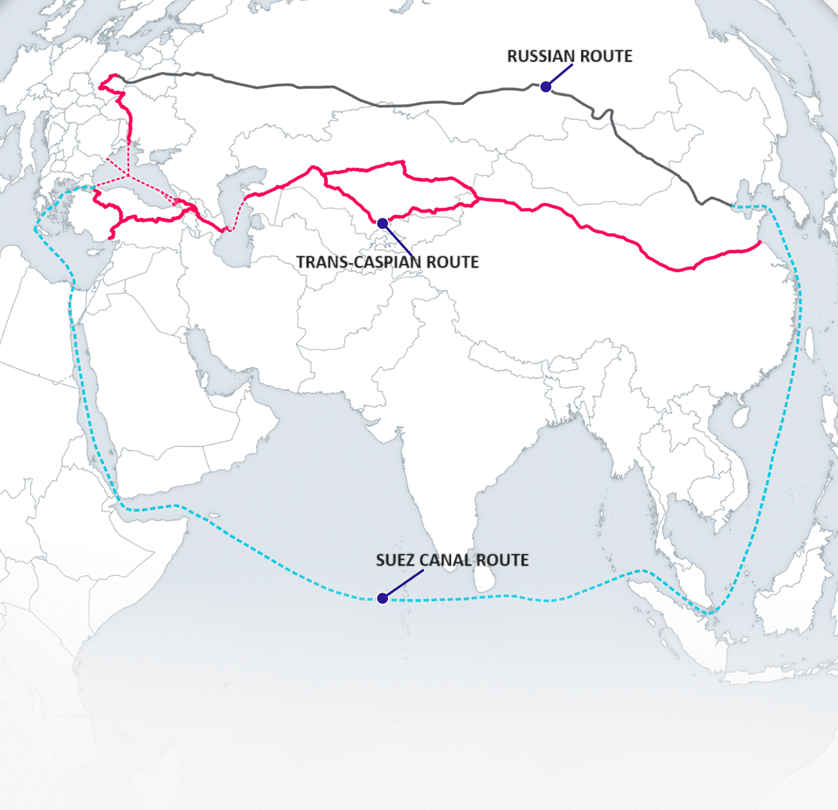The Revenge of the Southern Variant of the ‘Middle Corridor'
Averted until yesterday in commercial traffic between the East and Europe due to its too high costs, today the Transcaspian route with the blockade of relations with Russia due to the Ukrainian conflict has become the most viable solution. The World Bank estimates that 11 million tonnes of goods will transit it by 2030. But on its growth much will depend on Beijing's choices.
Astana (AsiaNews) - Regional conflicts always exert great influence on global trade relations, forcing many countries and companies to seek alternative routes in order not to block the dynamics of the economy. This is the lesson imposed by the events that began in 2022 with Russia's invasion of Ukraine, which shattered all trade ties, as well as provoking reactions of mutual hostility at various levels.
The so-called ‘Middle Corridor’, several thousand kilometres long between China and Europe via Russia, has long been the main trade channel between the worlds of East and West, with railways, transport terminals, ports and airports. Now everything is being challenged. In fact, most logistics facilities were built relying on the northernmost option, considered stable and less costly, and Russian railway companies had taken over the main role in the connections between China and Europe.
Now one is forced to look for possible alternatives due to war and sanctions, and transit between Europe and Asia ‘becomes more complicated and expensive every day’, as Romana Vlagutin, collaborator of the German Marshall Foundation and former EU Special Representative for Mutual Cooperation, comments. The Southernmost or ‘Transcaspian’ corridor, which was previously avoided as much as possible due to very high costs, very long waiting times at borders and ports, and poorly developed logistics infrastructure, is becoming increasingly important. Today, assures Vlagutin, it has instead become ‘the shortest and most multifunctional, considering also the interest of Central Asian countries in developing increasingly close and effective relations with the European Union’.
Statistics speak of an increase from 350 thousand tonnes of cargo in 2020 to 3.2 million tonnes as early as 2022, and World Bank researchers expect the volume of trade to reach 11 million tonnes by 2030, albeit with all the limitations that still persist in the route ‘bypassing’ Russia. According to Georgian expert Emil Avdaliani, professor of international relations at the University of Tbilisi, ‘a lot depends on what China thinks about the effectiveness of this route, because without Chinese cargoes there will not be enough energy to expand it and improve its efficiency’.
However, the European Union has started to support infrastructure projects in the various Central Asian countries and in the Caucasus, making around 10 billion available for the transport network from January 2024 and opening special representations for these initiatives in Georgia, Azerbaijan, Turkey and Kazakhstan. One of the initial landmarks is the city of Urumchi, capital of the Xinjiang Autonomous Province in China, which is gradually becoming one of the main hubs of the Chinese Belt and Road Initiative. Urumchi is connected with important centres such as Xi'an, the capital of the Chinese province of Shaanxi, 2,500 kilometres away, and points in the direction of Kazakhstan, a country that is also related in terms of its common Turkic ethnic groups and connected by an extensive network of railway lines, from where the Middle Corridor begins.
From eastern Kazakhstan, one then reaches Caucasian Georgia via two major routes, the Dostyk facing Russia and the southernmost Khorgos, on which the greatest investments are being concentrated, called the ‘dry port’ despite stretching 2,500 kilometres away from the coast. The Chinese cargoes are transferred to the Kazakh trains with large winches, continuing southwards through Aktau and the main city of Almaty to the Caspian Sea, where transports are blocked for weeks before continuing through Georgia to Turkey and the Black Sea. The aim is to reduce the journey to 12 days, from 19 through Russia and 23-37 in the Indian Ocean. But for now it is still a long wait.







.png)










